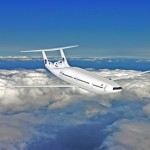Fly the (environmentally) friendly skies
May 16, 2010
on
on

MIT-led team designs airplanes that would use 70 percent less fuel than current models.
 In the CO2 emission rankings, aviation is high up there. But good news; MIT predicts a fundamental shift in commercial aviation. An MIT-led team has designed two green airplanes that are estimated to use 70 percent less fuel than current planes while also reducing noise and emission of nitrogen oxides (NOx).
In the CO2 emission rankings, aviation is high up there. But good news; MIT predicts a fundamental shift in commercial aviation. An MIT-led team has designed two green airplanes that are estimated to use 70 percent less fuel than current planes while also reducing noise and emission of nitrogen oxides (NOx).
The MIT D 'Double Bubble', as the plain is called, could possibly replace the Boeing 737 class aircraft, currently used for domestic flights, and the 350 passenger H 'hybrid wing body' series to replace the 777 class aircraft now used for international flights.
 The engineers conceived of the D series by reconfiguring the tube-and-wing structure. Instead of using a single fuselage cylinder, they used two partial cylinders placed side by side to create a wider structure whose cross-section resembles two soap bubbles joined together. They also moved the engines from the usual wing-mounted locations to the rear of the fuselage. Unlike the engines on most transport aircraft that take in the high-speed, undisturbed air flow, the D-series engines take in slower moving air that is present in the wake of the fuselage. Known as the Boundary Layer Ingestion (BLI), this technique allows the engines to use less fuel for the same amount of thrust, although the design has several practical drawbacks, such as creating more engine stress.
The engineers conceived of the D series by reconfiguring the tube-and-wing structure. Instead of using a single fuselage cylinder, they used two partial cylinders placed side by side to create a wider structure whose cross-section resembles two soap bubbles joined together. They also moved the engines from the usual wing-mounted locations to the rear of the fuselage. Unlike the engines on most transport aircraft that take in the high-speed, undisturbed air flow, the D-series engines take in slower moving air that is present in the wake of the fuselage. Known as the Boundary Layer Ingestion (BLI), this technique allows the engines to use less fuel for the same amount of thrust, although the design has several practical drawbacks, such as creating more engine stress.
Read the full article here.
 In the CO2 emission rankings, aviation is high up there. But good news; MIT predicts a fundamental shift in commercial aviation. An MIT-led team has designed two green airplanes that are estimated to use 70 percent less fuel than current planes while also reducing noise and emission of nitrogen oxides (NOx).
In the CO2 emission rankings, aviation is high up there. But good news; MIT predicts a fundamental shift in commercial aviation. An MIT-led team has designed two green airplanes that are estimated to use 70 percent less fuel than current planes while also reducing noise and emission of nitrogen oxides (NOx).The MIT D 'Double Bubble', as the plain is called, could possibly replace the Boeing 737 class aircraft, currently used for domestic flights, and the 350 passenger H 'hybrid wing body' series to replace the 777 class aircraft now used for international flights.
 The engineers conceived of the D series by reconfiguring the tube-and-wing structure. Instead of using a single fuselage cylinder, they used two partial cylinders placed side by side to create a wider structure whose cross-section resembles two soap bubbles joined together. They also moved the engines from the usual wing-mounted locations to the rear of the fuselage. Unlike the engines on most transport aircraft that take in the high-speed, undisturbed air flow, the D-series engines take in slower moving air that is present in the wake of the fuselage. Known as the Boundary Layer Ingestion (BLI), this technique allows the engines to use less fuel for the same amount of thrust, although the design has several practical drawbacks, such as creating more engine stress.
The engineers conceived of the D series by reconfiguring the tube-and-wing structure. Instead of using a single fuselage cylinder, they used two partial cylinders placed side by side to create a wider structure whose cross-section resembles two soap bubbles joined together. They also moved the engines from the usual wing-mounted locations to the rear of the fuselage. Unlike the engines on most transport aircraft that take in the high-speed, undisturbed air flow, the D-series engines take in slower moving air that is present in the wake of the fuselage. Known as the Boundary Layer Ingestion (BLI), this technique allows the engines to use less fuel for the same amount of thrust, although the design has several practical drawbacks, such as creating more engine stress.Read the full article here.
Read full article
Hide full article



Discussion (2 comments)
Wobbler 13 years ago
factor receivables contracts 9 years ago